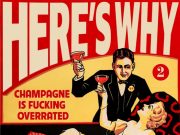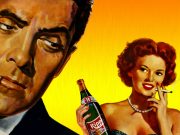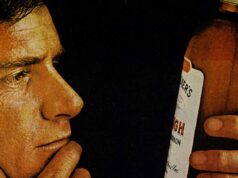When asked what he liked to drink, which was often, Charles H. Baker could have replied with great authority: “I Drink the World.”
Which probably would have earned him more than a few: “That’s fine, sir, but which portion of it would you care to drink right now?”
Not that Baker would have minded—he enjoyed a bit of give-and-take with bartenders and hosts, especially when it came to cocktail recipes. For a quarter of a century (roughly 1925-1950), Baker took as many as they were willing to give then unleashed them on the drinking world in his books and columns. There’s no telling how many cocktails he tried in his lifetime, but roughly 500 made it into print. Some were famous before he found them (Side Car, Manhattan), some he helped make famous (Death in the Gulf Stream, the Gin and Tonic, the Mojito), and some you will not have heard of (Buddha’s Blood, any of the four(!) Mallingholm Swizzles). And while you won’t find many of his collected recipes in today’s guides, you will detect their DNA throughout the contemporary cocktail kingdom.
Tall and gangling with angular features crossed by a thin Errol Flynn mustache, to call Baker handsome meant taking full measure of his considerable dash, style and charm. But there was something in that crooked, almost shy smile of his that converted detached strangers into hosts eager to entertain and explain. Most gave up their secrets willingly. A few, perhaps jealous of their discovery, may have intentionally fudged their recipes a bit.
Some of them certainly seem fudged. A few seem utterly preposterous and may have been surrendered in the same manner a local will reveal the best time for a tourist to hunt the local form of snipe (usually around 2am or whenever the bars let out).
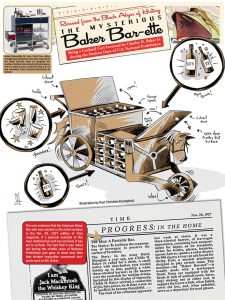 Or maybe you just had to be there. A Sahara Glowing Heart Cocktail[1] might come off as gustatorily bizarre in the uninspired confines of a drinking magazine’s office, but lapped up while “strolling in the midnight around the Sphinx with some congenial young woman companion” —well, under those circumstances it might taste like ambrosia poured directly from Ra’s own ruby-studded cocktail shaker.
Or maybe you just had to be there. A Sahara Glowing Heart Cocktail[1] might come off as gustatorily bizarre in the uninspired confines of a drinking magazine’s office, but lapped up while “strolling in the midnight around the Sphinx with some congenial young woman companion” —well, under those circumstances it might taste like ambrosia poured directly from Ra’s own ruby-studded cocktail shaker.
It’s not such a stretch to compare Baker to the celebrated Victorian explorers Dr. David Livingstone and Sir Richard Burton. While they boldly set out in search of riverheads, lost cities and fresh sources of malaria, Baker crisscrossed the globe tracking down legendary cocktails to their sources, bringing to light new tipples, and contracting, again and again, what he liked to call “lethal morning-after disease.” He lurched down the bustling back streets of exotic locales in road-wrinkled white linen suits, sniffing out hidden bars; he expertly bluffed his way into private clubs and gilded mansions, interrogating barmen and bigshots alike, all in a near-fanatical bid to catalog worthy cocktails and codify the rules of drinking.
The drinking world owes Mr. Baker a great debt. Not only for heroically rescuing cocktails tight roping over the black abyss of history, but gathering them in a such a way that elevated drinking from a sedentary sport, as many imagine it to be, to one of movement, mystery, and most of all, adventure.
Cocktail guides, then and now, are generally dull and derivative affairs with as much oomph as car repair manuals. Baker pushed the form into an entirely new dimension, wrapping each recipe with an exotic story and often a strong dose of drinking wisdom.
His writing style, like some of his cocktails, is initially jarring, but if you can get enough of it into your bloodstream, it becomes damned charming. His patois is a wild mix of high-toned Victorian dash and hard-boiled world-wise banter undershot with a rich vein of Deep South cracker-ese and an oft-employed secretarial shorthand. Not to mention enough offhand cultural incorrectness to send a liberal arts major shrieking toward the nearest safe space.
Interspersed among his recipes are many experience-polished “Words to the Wise” illuminating cocktailology and drinking behavior in general. The lessons dispensed run the gamut from innocuous and common-sensical (the importance of icing your shaker and glassware, to shake or not to shake) to the hard-boiled and grim (how to “salvage a guest from the effects of hanging by rope” and what to do if the “suspect liquor” you’ve been guzzling turns out to be poison—a not uncommon prospect during Prohibition.)
Below you’ll find a summoning up of a portion of his vast trove of dispensed wisdom.
Baker’s Dozen: Strong Advice from a Strange Man
A vast, shimmering web embraces the world, connecting all the Right Sort of People, and that web is called Booze.
Baker shared bar tabs (and recipes) with many of the first-rate boozers of his day, including Ernest Hemingway, William Faulkner, Douglas Fairbanks and Errol Flynn. It wasn’t mere coincidence that deposited them on adjoining barstools.
“All really interesting people—sportsman, explorers, musicians, scientists, vagabonds and writers—were vitally interested in good things to eat and drink,” noted Baker. “This keen interest was not solely through gluttony, the spur of hunger or merely to sustain life, but in a spirit of high adventure.”
Crossing all language, class and cultural barriers, the offer of a drink is the handshake for this excellent set, who knows what’s right when the sun slips over the yardarm, or any other arm for that matter. A shared drink is not only a form of welcome, it was an instant bond, a shared experience that put you and your newfound cousin on a common path to a more interesting place.
Moderate drinking is a measure of behavior, not quantity.
Baker held firm to the idea that moderate drinking wasn’t a matter of how much you drank, but rather how you drank. Baker often raises salutes to “moderate drinking” (in between tales of excesses), but you soon get the drift that to his gang this meant drinking as much as you want, so long as you don’t act too much the fool and ruin it for those around you. If you could sink a 1.75’s worth of rum drinks and remain a swell fellow and didn’t complain too loudly in the morning, you were drinking moderately.
Fear no booze.
Baker made a point of never refusing a drink, no matter how unpromising it might initially seem. Oh, he might grimace with alarm while the ingredients were thrown together, but he always gave it a go. He wasn’t so much worried about the mixer’s feelings (once given a go, he wasn’t shy about announcing a cocktail was a “freak fit only for the drain”), he just felt that every cocktail deserved a chance to shine.
There’s not a damn thing wrong with drinking alone.
Said Baker:
“We’ve never yet seen why the fact that you up-end a glass with no witness present should be classified as a sin apparently rating only 1 rung worse than incest and short-changing old maiden Aunts at Church Bazaars. Either it’s wrong to drink or it isn’t. Since it isn’t, why, the hell! What difference does it make because Bill and Babs is out? If we feel the need of a shorty we want to tell you that we yank the cork and pour—whether it be for need of a lift, the warding off of colds, forgetting of taxes or to neutralize serpent bites.
“Like our old Florida Cracker guide told us 1 time when on a swamp deer hunt we naively—then being of wide-eyed tender years—asked him if there was any better cure for snake-bite than a hold of store-bought liquor. He grinned and spat. ‘Who cares, Sonny?’ he said. ‘Who cares?’”
Indeed.
Baker’s BibleThe legendary 1946 leatherette edition of Around the World With Jigger, Beaker & Flask While bibliophiles may prize the 1939 first edition of this cocktail/drinking guide (paired with a cookbook and called The Gentleman’s Companion), those who engage in what Baker called “liquid field work” will prefer the 1946 standalone leatherette-bound reissue. Many were shipped with the buyer’s name embossed in gold (my copy at left is a refugee of NY Municipal Court Judge William J. Morris’s personal library), lending each a unique personality. |
You have no obligation to explain anything to anybody.
Between the intense and golden light he poured upon broad swaths of his life lay dark gaps his pen never touched. His second wife, for example, is an utter mystery, aside from a mention that the short encounter ended badly. As far as Baker was concerned, a man’s past, so long as he can contain it, belongs to no one but himself. He also held tight to the belief that any less-than-gentlemanly events that transpired during a booze-up could and sometimes should be sent down the memory hole, never to be mentioned again.
If you know how you’re getting there, you’re on an errand, not an adventure.
Baker missed a lot of boats (and later, flights) in his travels, sometimes intentionally, sometimes not. He never seemed to let it bother him. On the road—and in life—Baker became uneasy when everything was steaming along smoothly. It suggested that he might be in a rut. He understood that the path of least resistance almost always pulls drainward.
Nobody told Baker he could present himself as a global authority on drinking. He didn’t graduate with honors from a cocktailology college then apprentice under a known master of the drinking arts. He never asked anyone for permission, hell, he never even worked in a bar. He simply went forth into the world, drank as many drinks as he could get his lips around, absorbed as much knackered knowledge as experience and the experienced would lay on him, wrote it down, then unleashed himself on the drinking world.
There is no greater catalyst for adventure and happiness than alcohol.
In the forward of his first drinking guide, Around the World with Jigger, Beaker and Flask, Baker describes a wild series of adventures he experienced while in the grips of The Booze, then notes that had he instead been under the influence of strawberry soda or ice water none of those life-enriching moments would have happened. Not a single one. And he’d have been a much poorer man for it.
“That per hour of elapsed time, man and boy, we probably have been happier when mildly looking into the ruddy cup than at other times,” Baker posited. “Even granting our lethal morning-after disease we question if willingly we would exchange our hunting, fishing, or blue water sailing experiences for those mellow and gorgeously spiffed hours!”
Don’t forget where you’re from.
Going native is a fine thing if you don’t care for your current incarnation and plan on sticking around like Gaughan. But if you’re just passing through and fall into the habit of trading in pieces of your identity at each stopover, you end up feeling like a patched-up rag doll. Too many contemporary booze travelers on TV and in print are so eager to blend in with the natives, to not imperialistically “judge” the local culture and cocktails, that they lose all sense of perspective. Instead of being the outsider looking in, as they’re supposed to be, they frantically rub on cultural blackface and imagine they’re being sensitive.
While eager to try any and every local booze, Baker always spoke from his bedrock sense of self. He didn’t disguise who he was, nor did he apologize. Which the natives undoubtedly preferred to being aped.
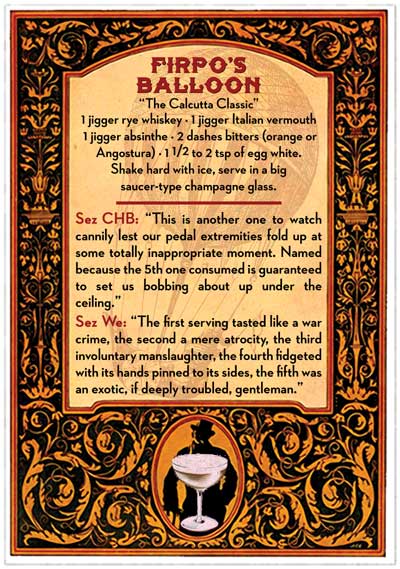 Anything can be improved, but that doesn’t mean it should be.
Anything can be improved, but that doesn’t mean it should be.
Oftentimes, instead of adjusting a recognizably flawed cocktail, Baker will metaphorically shrug and strongly suggest it be served “very cold indeed,” or, in the case of the Eagle’s Dream, send it packing: “Taste it. If you don’t like what eagles dream about, why, toss it down the drain. No one will lift an eyebrow.” He recognized that if you go around shaving off all the rough corners you end up with a bag of balls that all look roughly the same. Just as strikingly beautiful women always possess a singular “flaw,” some cocktails stand out because they are not perfectly tuned to the tastes of the masses.
Mixology is medical science.
Or at least alchemy. Before Big Pharma marched in with their vast and shrill cacophony of insanely dangerous drugs, alcohol was used by mankind to address all sorts of mental and physical calamities, and it’s plain Mr. Baker was a world-class practitioner of the form. He described and prescribed the presently misplaced (if not lost) art of the Picker-Upper, those lively, sometimes outlandish cocktails that cause “the numbed nerve centers to nod closer and closer together until they, at long last, touch and the day is begun!” He also wrote Rxs for Nerve Soothers, Pain Relievers, Spine-Stiffeners and Brain-Fixers.
When traveling through foreign lands unbothered with modern concepts of sanitation, Baker considered steady drinking not only a fine time but a medical necessity. Teetotalers, he observed, were much more likely to get sick and/or die while abroad while he and his merry band remained healthy and hardy. The reason, he explained, was “. . . we never permitted the setting sun—or at least midnight curfew—to find our mouth, throat and alimentary linings unfortified with at least a daily minimum of 1/2-a-5th of good liquor.” It should be noted that Baker continued this regimen until he died at the ripe old age of 91.
A cocktail is more than what’s in the glass.
Where, with whom, and under what circumstances you imbibe that drink has an immense effect on its taste and perceived quality. Which may explain why so many of today’s mixologists “correct” and sometimes sneer at many of Baker’s recipes. Some have even suggested that Baker included outrageously bad recipes to lend a sense of scope, that decent recipes will shine all the brighter when sitting next to monstrous ones.
What they’re missing is Baker included some cocktails not because they were particularly good, but because they offered an accurate portrait of a place and time. A Jersey Lighthouse taken in the company of William Faulkner during a blizzard is going to possess a singular flavor that may not translate under less poignant circumstances. The context of the moment and the lingering nostalgia are as much an ingredient as booze or bitters. You don’t have to wonder why the Farewell to Hemingway cocktail, conspired during a booze up with its namesake the evening prior to Papa flying off to cover the Spanish Civil War, found its way onto page. To Baker, certain cocktails were bookmarks in a life well lived.
“Each one of them fetches joyous memory of some friend, place, or adventure; is flanked with happy memory of a frosted glass, a smile, the sip of something which is perfect,” wrote Baker of his collected cocktails. “No, nothing shall ever pirate away those memories.”
You have to dig through a lot of coal to find a diamond.
God and the Devil know how many different concoctions sluiced down Baker’s courageous throat during his lifetime, but it was surely in the thousands. During his first round-the-world cruise in 1931, he packed along the fattest cocktail guide available and swore he tried each and every recipe during five-months’ worth of international travel. He was aghast at how bad most of them were. From that point on, Baker felt it his sacred duty to right the many terrible wrongs done to the nation’s cocktail culture by that societal hurricane known as National Prohibition, even if it meant drinking and vetting every cocktail known to humankind.
Now, what qualifies as a diamond is entirely subjective. It’s instructive to note that Baker once said that he doubted if there were 170 “good” cocktails in the world, yet he published nearly 500 recipes.
Maybe he reckoned that coal, while not as precious as diamonds, is still a damned fine fuel.
- “Take of dry gin, 1 pony, absinthe, 1 pony, dry imported apricot brandy, 1 pony; donate 1/2 pony of bright rose colored grenadine. Shake with lots and lots of ice and strain into a large saucer champagne glass, and pray to Allah for forgiveness of all imminent and future sins of the flesh.”-CHB ↑



